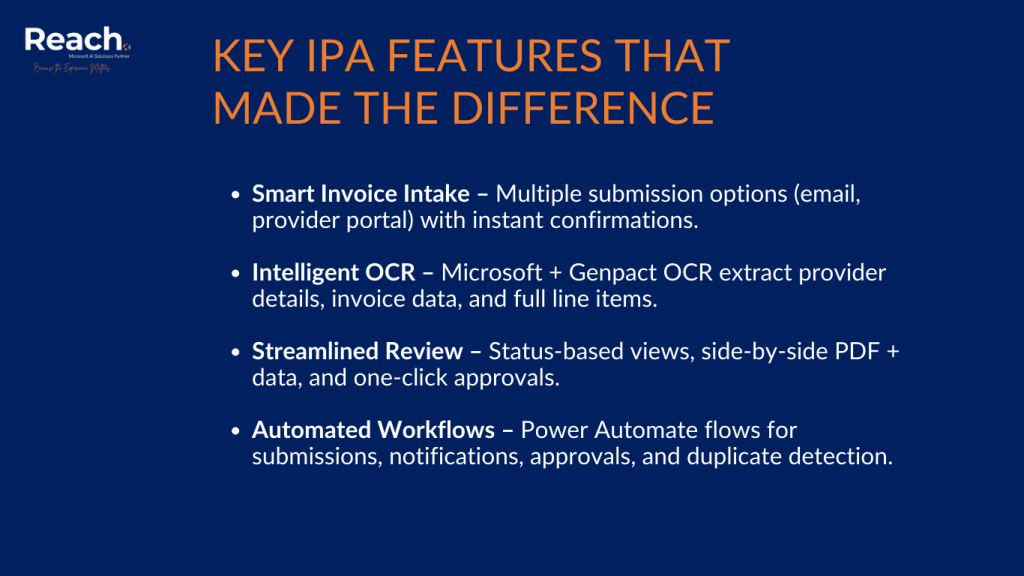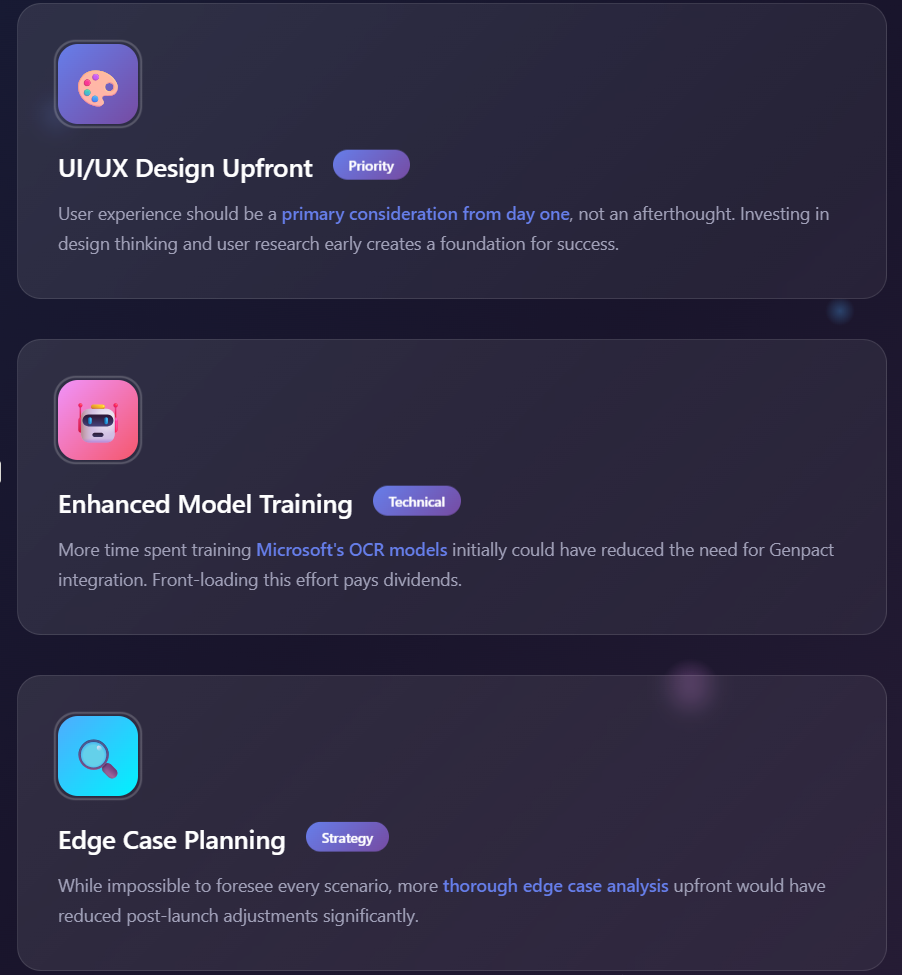In fast-paced healthcare ecosystem, efficiency isn’t just about cost savings—it’s about enabling care providers to focus on what matters most: patient care. When CareScout‘s customer support team was spending 15 minutes manually validating each invoice from care providers, we knew there had to be a better way. What started as a time-consuming bottleneck with Microsoft Power Platform that became the catalyst for an innovative solution that would save the organization $1 million in labor costs within just eight months.
The Challenge: Manual Invoice Processing at Scale
CareScout operates as a crucial intermediary in the healthcare network, connecting care providers with care recipients. Our customer support team processes invoices that serve as proof of service delivery, validating them before they’re passed along in the payment chain. With 3,500 to 4,000 invoices flowing through our system monthly, the manual validation process had become unsustainable.
The old workflow was entirely manual: each invoice required individual review, manual quote calculation, and manual processing back to providers. Not only was this time-intensive, but it also created opportunities for human error and delays that frustrated our network partners.
The Solution: Building the Invoice Processing Application (IPA)
Recognizing the need for automation, we developed a comprehensive Invoice Processing Application using Microsoft Power Platform. Our primary goal was simple yet ambitious: dramatically reduce the time needed for manual invoice validation while maintaining accuracy and improving the overall user experience. By leveraging the capabilities of the microsoft power platform, we were able to enhance our processes significantly.

Key Features That Made the Difference
Smart Invoice Intake We created multiple submission channels to accommodate our providers’ preferences:
- Email submission for providers who prefer traditional communication
- Dedicated provider portal for those wanting more control over their submissions
- Automatic email confirmations to keep providers informed throughout the process
Intelligent OCR Integration The heart of our system leverages Microsoft’s OCR technology, later enhanced with Genpact’s specialized OCR services. The system automatically extracts critical information including:
- Provider details (name, phone number)
- Invoice metadata (number, date, care recipient)
- Line items with full breakdowns (description, quantity, amounts, overtime calculations)
Streamlined Review Interface Our team needed an intuitive way to manage the invoice pipeline. The application provides:
- Status-based invoice organization (incoming, new, ready for review, error states, missing provider)
- Side-by-side PDF preview with extracted data for easy validation
- Simple tools to manually adjust, create, or delete line items when needed
- One-click approval process that automatically triggers case creation
Automated Workflow Management Behind the scenes, we implemented several Power Automate flows:
- IPA Processing: Handles initial submission and routes to Genpact
- Line Item Extraction: Retrieves processed data from Genpact’s system
- Email Notifications: Keeps providers informed of submission status
- Approval Processing: Manages the complete approval-to-delivery pipeline
- Duplicate Detection: Prevents processing conflicts with intelligent case matching
The Transformation: Measurable Impact
The results exceeded our expectations across every metric:
Time Efficiency
- Processing time per invoice: 15 minutes → 3-5 minutes
- Monthly processing capacity maintained with significantly reduced staff time
- Freed up customer service resources for higher-value activities
Accuracy Improvements
- 90% precision in automated line item extraction
- Reduced manual data entry errors
- Consistent processing standards across all invoices
Cost Savings
- $1,000,000 saved in labor costs in the first 8 months
- ROI achieved within the first quarter of implementation
- Scalable solution supporting business growth without proportional staff increases
User Experience
- Dedicated invoice validation team can focus on exception handling
- Providers receive timely updates on their submission status
- Streamlined approval process reduces payment delays
Technical Challenges and Solutions
Building an automated invoice processing system presented unique challenges, particularly in healthcare where standardization is limited.
The Standardization Problem Healthcare invoices come in countless formats—some spanning nine pages with extraneous content, others featuring handwritten notes, and many poorly scanned documents. Our initial Microsoft OCR integration struggled with this variability.
Solution: We partnered with Genpact, whose specialized team and advanced OCR technology could handle these edge cases effectively, dramatically improving our data accuracy.
Edge Case Management Real-world implementation revealed numerous scenarios our initial design hadn’t anticipated:
- Provider names exceeding 150 characters
- Service descriptions longer than 500 characters
- Unusual invoice formats and layouts
Solution: We developed an iterative improvement process, updating our Power Automate flows with each new edge case discovery. While this initially caused some processing delays, it ultimately created a more robust system.
User Experience Refinement Early feedback highlighted opportunities for better UI/UX design and more intuitive navigation.
Solution: We prioritized user experience improvements in subsequent iterations, though we identified this as an area for greater upfront investment in future projects.
Lessons Learned and Future Considerations

What We’d Do Differently
- Invest More in UI/UX Design Upfront: User experience should be a primary consideration from day one, not an afterthought.
- Enhanced Model Training: More time spent training Microsoft’s OCR models initially could have reduced the need for Genpact integration.
- Comprehensive Edge Case Planning: While impossible to foresee every scenario, more thorough edge case analysis upfront would have reduced post-launch adjustments.
The Path Forward
While our Invoice Processing Application has been tremendously successful, technology evolution never stops. We’re currently developing a next-generation custom application that will eventually replace the IPA, incorporating all the lessons learned from this implementation.
For now, we’re maintaining the current system while planning the transition, ensuring continuity of service for our provider network.
Key Takeaways for Similar Projects
Start with Clear Metrics: Our focus on reducing processing time from 15 minutes to under 5 minutes provided a clear success benchmark that guided every development decision.
Embrace Iteration: The willingness to continuously improve our Power Automate flows based on real-world usage was crucial to achieving 90% accuracy.
Choose the Right Technology Partners: The transition from Microsoft OCR to Genpact’s specialized solution was pivotal in handling healthcare invoice variability.
User Feedback is Gold: Our customer service team’s input throughout development ensured the final product actually solved their daily challenges.
Plan for Scale: Processing 3,500-4,000 invoices monthly required robust architecture from the start.
Conclusion
The Invoice Processing Application transformed CareScout’s operations, proving that thoughtful automation can deliver both immediate cost savings and long-term operational efficiency. By reducing invoice processing time by 70-80% while maintaining high accuracy, we’ve created more value for our providers, our team, and ultimately, the care recipients we serve.
The $1 million in labor cost savings within eight months speaks to the financial impact, but the real success lies in enabling our team to focus on higher-value activities that directly support our healthcare network. As we continue to innovate and improve our processes, this project serves as a foundation for future automation initiatives.
Are you facing similar challenges with manual processing workflows? The combination of Power Platform’s accessibility and specialized OCR services might be the solution you’re looking for. The key is starting with clear goals, embracing iteration, and keeping user experience at the center of your design decisions.

